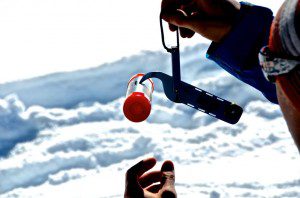30 Mar TELLURIDE MOUNTAIN SCHOOL INVESTIGATES LOCAL WATERSHED, PART FOUR
Editor’s note: For two weeks, Telluride Mountain School High School students put aside textbooks and turned their attention to water. With the help of local experts on water and media, they researched, wrote, and presented everything there is to know about Telluride water– where it comes from, how it’s cleaned, and what the fate of future snowpack is. This fourth entry, by freshman Theo Rolfs, is part four of a five-part series on Telluride watershed.
Snow: Telluride’s Cold Commodity
Theo Rolfs
What’s your favorite word to describe snow? Mine is blissful. Many of us, when we think about snow, picture a powder day filled with face shots. The snowpack, though, affects people much more than powder skiing. In Telluride, the town’s economy relies on a good snowpack. Without it, there would be no tourists, no ski area, and no rivers. In towns like Telluride, the snowpack plays a bigger role than you might think: it affects everyone from the powder skier to the farmer.
Snowpack is how much snow we have, and how stable it is, recorded on a 30-year average. With only two big storms in the early part of our winter, our early snowpack was low. By January, the snowpack was recorded at only 49% of the average. When Telluride has a low snowpack, not only is it bad for the skiing but it also affects the spring runoff. A low snowpack means low runoff, which means low river levels, which affects businesses such as raft guides.
When looking at the snowpack, it is not only important to look at the depth, but also the stability. Early this season our snowpack was not only low, but unstable. The bad early season snowpack left us with a heck of a lot of facets and depth hoars. Facets and depth hoars are huge crystals that form when it’s dry and really cold. Depth hoars can be as big as one’s hand. They make the snowpack incredibly unstable.
To imagine how depth hoars affect the snowpack, picture a table with a ton of wine bottles on it. Then, put a piece of plywood on the wine bottles and tilt that table up to an angle. All the bottles and wood will fall off. This is what our snowpack was like in January. The table represents the ground, the wine bottles represent the depth hoars, and the plywood, the new snow.
In February, it snowed 40 inches in one week and then another 26 inches the next. This one big storm cycle brought the average snowpack from 49% to 98% of the 30- year average. The new snow also caused the weak layers to slide out underneath, which is dangerous in the short term, but will make for a more stable snowpack in the long term.
The snowpack is not just important for winter skiers. It is actually just as important when it melts. Farmers depend on snowpack.
Guide companies do, too. If there is low runoff, the rafting business may have a shorter season. A low runoff will also negatively impact farmers who will have less water to grow their crops.
Snowpack affects you, whether you know it or not. Telluride’s tourist economy depends on people visiting Telluride to ski and go outdoors. A low snowpack not only affects our winter economy but our summer economy as well. Remember when we had water restrictions and were not allowed to have fireworks in July? That was due to a low spring snowpack combined with less than average early summer rainfall.
Snowpack is a serious matter in a mountain town like Telluride. We all depend on it for our livelihood, and our jobs.
Check out this podcast with Ben Thorneycroft to learn more about what Telluride Mountain School discovered about the value of water.
See all the photos and stories from the Telluride Mountain School water project here.




Sorry, the comment form is closed at this time.